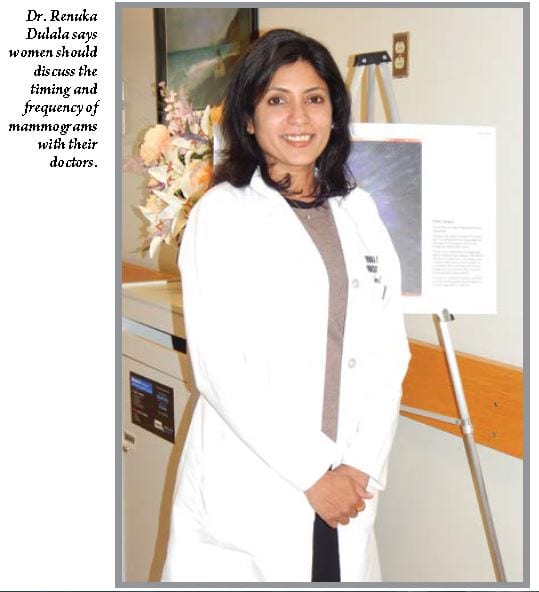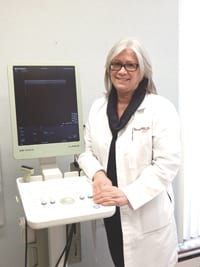Screen Test – Mammograms Can Help Reduce Deaths from Breast Cancer
Every year, Dr. Lisa Planeta sees about six patients with large, cancerous breast tumors who have never had a mammogram.
It’s unfortunate because advances in medicine have led to myriad treatment options that didn’t exist several decades ago, and if the disease is detected in the early stages, the five-year survival rate is 100{06cf2b9696b159f874511d23dbc893eb1ac83014175ed30550cfff22781411e5}.
“In the ’70s and ’80s, there was really only one way to treat breast cancer,” said the Mercy Breast Care Center surgeon. “If a woman had a lump that was palpable enough to feel, she was put under anesthesia, and a biopsy was sent to the lab. If it came back positive, surgery was done immediately; there were no choices, and the woman had no time to prepare for it.”
Today, needle biopsies are done under local anesthesia using ultrasound or other forms of guidance that allow the needle to be inserted directly into the lesion or abnormal area. And even if the biopsy results are positive and cancer is found, radical mastectomies have given way to lumpectomies as well as treatments with new chemotherapy drugs that target specific cells.
But screening is still key to early discovery, and the goal is to identify cancer before it spreads. Mammograms are the best screening tool available, but last fall the American Cancer Society (ACS) changed its recommendations regarding testing due to debates over the stress and cost related to false positives.
A false positive occurs when something suspicious shows up on a mammogram that leads to more testing or procedures that cause emotional stress and ultimately don’t show any cancer. So, since fewer than 15{06cf2b9696b159f874511d23dbc893eb1ac83014175ed30550cfff22781411e5} of breast cancers in the U.S. are found in women under the age of 45, the ACS now recommends that women with average risk factors begin having annual mammograms at age 45, then switch to screenings every two years when they reach 55. However, the guidelines also state that women 40 to 44 should have the option to begin screenings early, and those 55 and older should be able to continue annual screenings if they choose to do so.
But many groups, including the American College of Obstetricians and Gynecologists, disagree with the new guidelines and still recommend getting screened at age 40, because the 15{06cf2b9696b159f874511d23dbc893eb1ac83014175ed30550cfff22781411e5} of women who do have breast cancer benefit from finding it early.
“It’s something women should discuss with their doctors,” said Dr. Renuka Dulala, an oncologist and hematologist at Holyoke Medical Center, explaining that the choice is personal and relative to each woman’s lifetime risk for breast cancer, which is determined by her age, family history, genetics, exposure to estrogen, and other factors.

Advances in Treatment
Advances have been made in mammography in recent years, and breast tomosynthesis, also known as 3D mammography, has been available in the U.S. since 2011. It was originally approved by the Food and Drug Administration to be used along with standard, two-dimensional digital mammograms, but in 2013, the agency did approve a 3D system that can be used alone.
Conventional mammography takes images of the breasts from two angles. In contrast, the 3D scanner moves in an arc over the breasts, taking images from various angles.
Mercy Medical Center and Cooley Dickinson Health Care both offer tomosynthesis in conjunction with standard, 2D imaging on the same scanner, and although all women don’t choose to have it, the additional images can make it possible for the radiologist to gain a better understanding of the patient’s breast tissue.
Deborah Grandmont feels there are real advantages to the new technology because it provides images in one-millimeter sections that the radiologist can manipulate, magnify, lighten, or darken, which provides them with an unparalleled view of the tissue.
“I think of it as a more thorough, more in-depth mammogram, and believe it will become standard of care in the future. It looks at the breast in a manner that wasn’t available three years ago and is particularly useful for women with dense breasts,” said Grandmont, the women’s imaging supervisor at Cooley Dickinson Health Care, adding that its use of the 3D imaging has reduced the number of callbacks by 25{06cf2b9696b159f874511d23dbc893eb1ac83014175ed30550cfff22781411e5}. A callback occurs when a mammogram picks up something suspicious and the doctor wants to do additional imaging or a biopsy. According to the American Cancer Society, fewer than 10{06cf2b9696b159f874511d23dbc893eb1ac83014175ed30550cfff22781411e5} of women called back for more testing are diagnosed with breast cancer.
But, despite the purported benefits, some women shy away from tomosynthesis because there is a small increase in the amount of radiation they are exposed to, which they view as a cause for concern.
“These patients have the option of having a mammogram without 3D imaging, but the dose of radiation is so low that the benefits far outweigh the cost,” Grandmont said. Still, the cost of 3D imagining is usually higher, and some insurance companies don’t cover tomosynthesis or assign high co-pays to it, which can be a deterrent for some women.
But the type of mammography they choose is less important than having a mammogram on a regular basis.
Holyoke Medical Center doesn’t offer 3D imaging, but Dulala doesn’t consider it problematic. “If anything is suspicious, we can order an ultrasound or an MRI as an adjunct,” she told HCN.
It’s easy for women diagnosed with breast cancer to be overwhelmed by the number of choices available to them, so Planeta advises them to seek input from healthcare providers who can help them make educated decisions.
“In this country, we really try to steer people toward breast conservation and minimal surgery,” she noted, adding that, although some women think having a bilateral mastectomy will not only remove all of the cancer but prevent a reoccurrence, research does not bear that out.
“Having a mastectomy instead of a lumpectomy confers no survival advantages for women with stage 0, stage 1, or stage 2 breast cancer,” she said, citing a study that followed women under 55 with early-stage cancers who chose one surgical procedure over the other. “There are cases where mastectomy is the only option, but for most women, a lumpectomy is not only possible, it is preferable. Having a mastectomy is not going to provide a better cure or reduce the chances of having the cancer appear somewhere else in the body.”
Exceptions may include women with genetic mutations, but only 0.2{06cf2b9696b159f874511d23dbc893eb1ac83014175ed30550cfff22781411e5} of the population falls into this category.
Dulala concurs. “Surgery has become less intense, and we don’t do extensive lymph-node dissection today, which makes it less disfiguring and lowers post-operative complications such as edema or swelling in the arms,” she said.
Indeed, change has occurred even when breast cancer is diagnosed in the late stages, as chemotherapy is often administered prior to surgery in hopes of shrinking the tumor. And if a mastectomy is deemed necessary, there are many more options for reconstruction today than there were in the past.
But Dulala says it is preferable for a woman with breast cancer to see an oncologist before making any decisions, because they are the physicians who will follow them after surgery or treatment, and can work as a team with all the healthcare providers involved with the patient.
“Breast cancer has become a very treatable disease, and some patients who are diagnosed at stage 4 can live for six years or longer,” she told HCN.
Still, the outcome depends on several factors, including the patient’s physiology and how aggressive the cancer is. If the disease is diagnosed before age 40, it tends to be more aggressive, while breast cancer identified between the ages of 70 and 80 typically is less aggressive.
Chemotherapy has also come a long way in the past decade, and anti-nausea medications are given the day before treatment starts, then administered intravenously and taken when the patient returns home, which has done a lot to reduce one of the most debilitating side effects.
Side effects of radiation, which can include peeling skin and redness, are also mitigated today as patients are asked to apply moisturizer as a preventive and continue using it throughout their treatment.
Preventive Measures
The American Cancer Society no longer advises women to do monthly breast self-exams, although they should contact a physician if they feel a lump or unusual change in their breast.
Mammograms are critical, but Planeta says regular exercise, which can be as simple as walking 30 minutes a day, and maintaining a healthy weight can help reduce the risk of breast cancer, and is especially important for post-menopausal women and cancer survivors.
But every woman should begin having an annual mammogram at age 45, 40, or earlier, depending on her family history and genetics. And although the screening isn’t perfect — some cancers are missed, and false positives lead to anxiety and unnecessary testing — the procedure takes only 20 minutes and causes minimal discomfort.
Ultimately, mammography saves lives, and the earlier breast cancer is diagnosed, the better the chances are of surviving the disease.



Comments are closed.